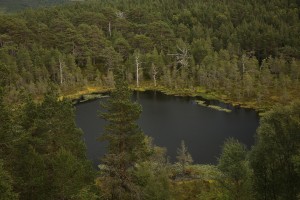
After spending a couple of hours at the oak tree (Quercus petraea) and young hazel (Corylus avellana) near Badger Falls in Glen Affric in early July, which I wrote about in the first part of this blog, I headed further west to Dog Falls, where the footpath to Coire Loch begins. Before setting out to walk to the loch though, I spent some time looking around the area near the falls themselves – in previous years I’ve found quite a lot of interest in a small clearing there.
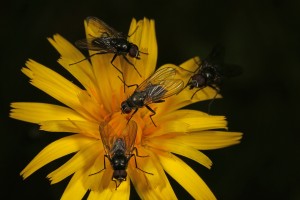
Last year I’d found aphids feeding on some autumn hawkbit plants (Leontodon autumnalis) in the clearing, and I was keen to see if they would be there again now. Because many aphid species are host-specific, and are flightless for much of their annual life cycle, they often occur year after year on their host plants in the same location. As I entered the clearing and saw the hawkbit plants, my eye was drawn by a lot of activity on some of their flower heads. There were a lot of flies, taking advantage of the sunny weather and feeding on the blossoms. I was subsequently able to get them identified by Peter Chandler as being a common species (Thricops innocuus) that regularly visits flowers.
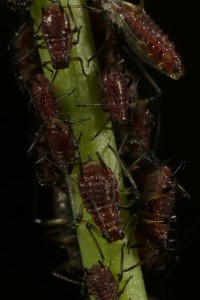
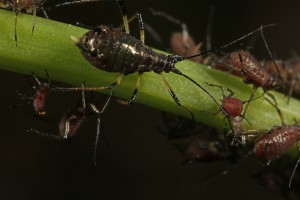
Looking below the flowers on some of the autumn hawkbit plants, I soon discovered aphids on several of them. Last year, these had been identified by Bob Dransfield and Bob Brightwell, two aphid specialists who did a survey for us at Dundreggan, as being a species called Uroleucon hypochoeridis.
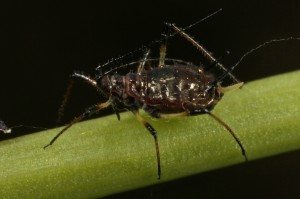
I was cautious though about assuming they were the same species this year. There’s a similar species called Uroleucon leontodontis that had been found on some autumn hawkbit by Ed Baker at Dundreggan in 2012, but when Bob Dransfield and Bob Brightwell looked at the same plants in 2013, they found Uroleucon hypochoeridis aphids there. It’s conceivable that a similar variation could occur with the aphids on these hawkbit plants in Glen Affric, so I’ve sent some specimens to Ed Baker to get them identified.
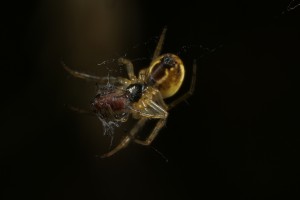
I spent a few minutes watching and photographing the aphids, remembering as I did so that last year at the same spot I’d been fortunate to see and photograph one of the aphids giving birth to a live nymph. This time, I witnessed a drama of a different kind, because while I was looking at the aphids, a spider appeared and grabbed one of the immature nymphs, which are defenceless as they feed on the stem of the plant. It was easy pickings for the spider, and it moved away on one of its silken strands, wrapping the aphid in silk as it did so.
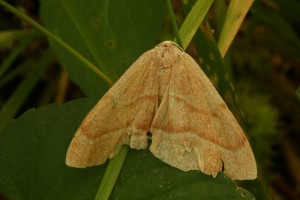
At the edge of the clearing where the autumn hawkbit plants were growing there’s a large goat willow tree (Salix caprea) that I was keen to look at, to see what life it might be supporting. As I approached it, my eye was drawn to a brown shape on the vegetation beneath the tree, and when I looked closely I saw that it was a good-sized moth. It was sitting there motionless, no doubt relying on the fact that it wouldn’t be seen before it became active at night. I didn’t recognise the moth at the time but I was later able to identify it as being the barred red (Hylaea fasciaria).
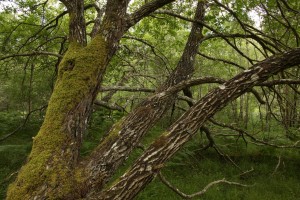
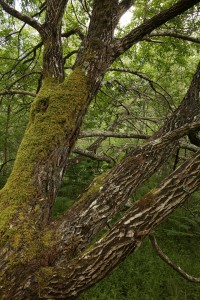
This goat willow is a particular favourite of mine, as it has an interesting shape and a distinctive pattern on its bark, as well as lots of moss growing on its trunk. The latter is due to the high moisture content in the air in this narrow section of the glen, where there is plenty of spray in the air from the falling water at Dog Falls, which creates ideal conditions for mosses to flourish in.
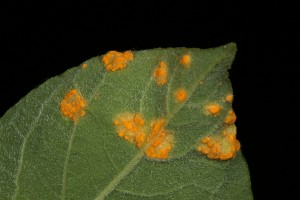
Reaching the tree, I began having a look at some of its leaves and almost immediately I found something of interest. There were clusters of orange swellings on the underside of several leaves, and I recognised them as galls caused by a fungus. We’ve recently bought a book of keys to identifying galls, for a training day about galls that I’m leading in August, and using that I was able to identify them as being induced by a rust fungus (Melampsora caprearum).
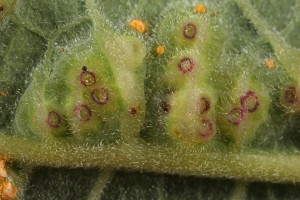
Willows are the genus of trees that are host to the greatest number of different plant galls in the UK, and there are several different types of galls that occur on goat willow. Turning over some other leaves on this tree, I soon found some different galls, this time induced by a midge (Iteomyia capreae). These take the form of clusters of small hard swellings, with distinctive red rims on their undersides.
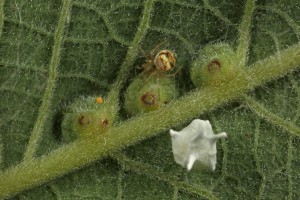
There were quite a number of leaves with these galls on them, and on one of those I also found a female spider guarding her egg sac. It was the same species (Paidiscura pallens) I’d seen on the oak tree earlier in the day, and I was particularly pleased with the photograph I took of it now, with both the spider and the egg sac naturally positioned in an aesthetically-pleasing way amongst the galls. There was also a small example of a gall induced by the rust fungus (Melampsora caprearum) beside one of the midge galls, so this image provides a remarkable juxtaposition of four different species (including the tree) on this one leaf.
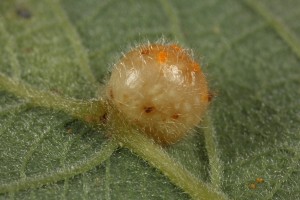
On the underside of another leaf, I found a different gall again. This one was induced by a sawfly (Eupontania pedunculi) and had the form of a larger spherical swelling that was slightly hairy. These galls can be up to 5 mm in diameter, and have a yellowish scar on the top surface of the leaf. This particular one also had some examples of the galls induced by the rust fungus (Melampsora caprearum) on the top of it.
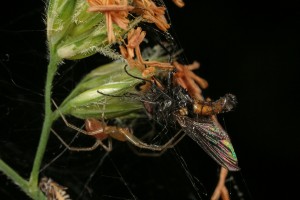
Taking a pause from looking at the goat willow’s leaves, I noticed some movement on a plant on the ground. Looking closely, I saw it was a spider with a fly it must have just caught. I was able to get this identified later by Peter Chandler as a male of a common species (Thricops semicinereus) that is widely distributed across the north of Europe and Asia.
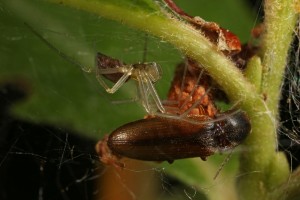
Nearby, I spotted another spider, and this one had caught bigger prey – a common click beetle (Athous haemorrhoidalis). The beetle was larger than the spider itself, but seemed to have been subdued all right, as it didn’t move at all while I watched and photographed it. This was the third spider I’d seen with prey in this area, and it reminded me of how much predation there is going on in the world of the small creatures around us, which is easy to overlook.
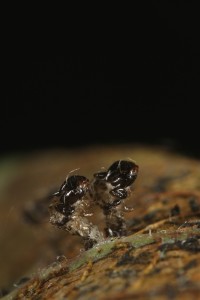
Turning back to the goat willow tree itself, I noticed feeding damage on some leaves that looked to be typical of that caused by the larvae of beetles. This was confirmed when I saw a larva on one of the leaves.
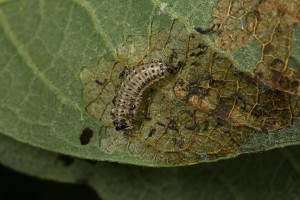
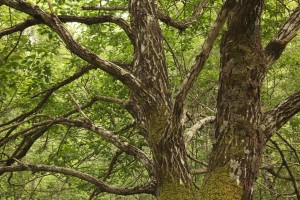
I didn’t recognise the larva, so I collected the specimen to rear it at home, as in most cases beetles like this can’t be identified from the larval stage – adults are required to determine which species they are. There were a few of these larvae on the leaves, and I also noticed further evidence of where they had been feeding. In addition to the clearly stripped sections of the leaves, there were strangely-balanced dark blobs nearby – these were piles of frass, as the waste product of caterpillars and the larvae of other insects is known as. At the time of writing, the beetle larva I collected hasn’t undergone its metamorphosis into an adult yet, so I still don’t know what species it is.
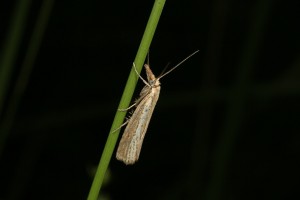
While I was looking at the leaves of the goat willow, I noticed something land on the stem of some grass that was growing underneath the tree. It was a micro moth, and I managed to take a single photograph of it before it flew away again. I was later able to get this identified by Bob Heckford as being a common species – the pearl veneer moth (Agriphila straminella) – the larvae of which feed on various grasses.
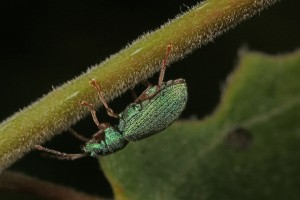
Moving on from the goat willow, I went to see the young aspens (Populus tremula) that are growing beside Dog Falls. When I’d looked at them during my visit back in June, there had been quite a number of silver-green leaf weevils (Phyllobius argentatus) feeding and mating on them. This time I spotted a single example of this bright-coloured, metallic-appearing weevil, on the stem of one of the aspens.
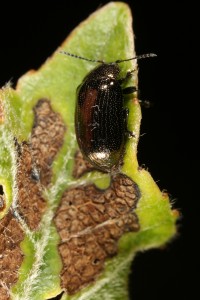
During my earlier visit in June, I’d also seen some common leaf beetles (Phratora vitellinae) mating on these aspens, and the results of that were visible now, as their larvae were feeding on the aspens’ leaves.
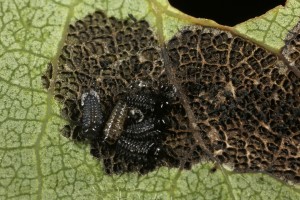
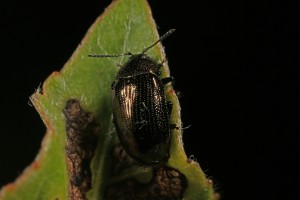
This beetle occurs on aspens throughout the area where Trees for Life works, and last year I’d collected some of the larvae and took them home to rear to adulthood, feeding them with leaves from the young aspen tree in my garden. After a while some of them pupated and I sent one of the adult beetles that emerged to Richard Lyszkowski, a beetle expert, who confirmed the species identification. Previously I’d only been able to identify the adults, but this gave me the confidence to also recognise the larvae of the species.
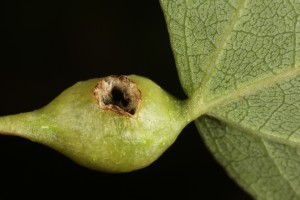
On another aspen leaf I noticed a swelling on the stem, or petiole. This was a gall induced in the stem by a midge (Contarinia petioli), which is quite distinctive and easily-identifiable. In this case, the midge larva must have pupated into an adult and left the enclosed space within the gall, as there was an exit hole clearly visible in the side of the gall itself. Like the leaf beetle, this is also a common species, and I find it on many aspen trees in Glen Affric and at Dundreggan each year.
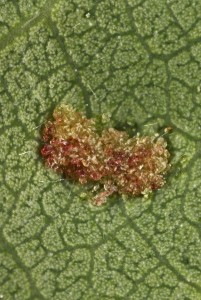
On a different aspen leaf I found another gall. This one was induced by a mite (Phyllocoptes populi) and took the form of a swelling on the top of the leaf, with a felt-like area called an erineum underneath.
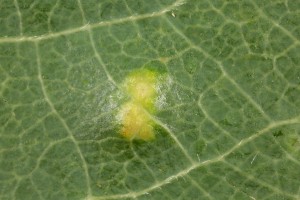
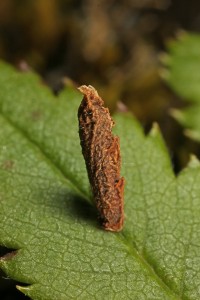
Turning my attention to a nearby rowan tree (Sorbus aucuparia), I found a small structure on one of its leaves. This was a distinctive case made by the larva of a micro moth (Coleophora serratella) – I’d seen this species on a hazel leaf near Badger Falls last month.
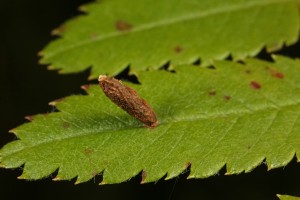
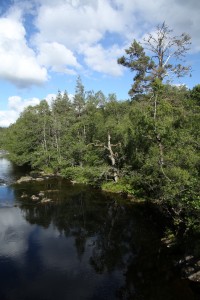
By this time it was past mid-afternoon, and I’d spent most of the day at a handful of trees, so I began (finally!) to walk on the trail from Dog Falls towards Coire Loch. There’s a footbridge across the Affric River near the start of the trail, so I stopped on it for a few minutes to enjoy the view of what was now a beautiful sunny day. Looking towards the forest on the other (south) side of the river, I noticed that a large Scots pine (Pinus sylvestris) there was dying from the top down. It was the first time I’d noticed this, so it must have begun its decline relatively recently as I walk along this trail fairly regularly. Many of the older trees in the Caledonian Forest remnants such as Glen Affric are reaching the end of their lifespans like this, and are dying naturally from the top down, with the process taking several years for the life force to disappear from all of the tree.
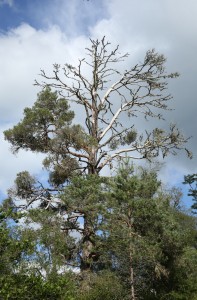
It’s a gradual process of attrition, and once the tree is completely dead, the wind will quickly remove the needles and small twigs. The remaining trunk and larger branches form what is known as a snag, and because of the high resin content in the wood, these snags can persist for many decades or even a century before they collapse and rot away.
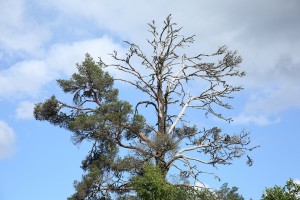
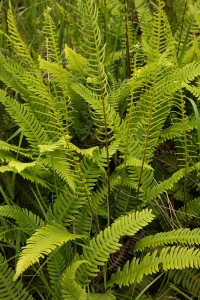
Further along the path, I came across some nice clumps of hard fern (Blechnum spisant). This is a hardy evergreen fern, which produces two distinctly different types of fronds. The commonest fronds are the sterile fronds – those which grow on or close to the ground, spreading outwards in a more or less horizontal direction. In amongst them are the fertile fronds. They are narrower and grow vertically upwards, presumably to facilitate the distribution of the fern’s microscopic spores by the wind – a process which is more effective and pronounced the further above the ground the fronds are.
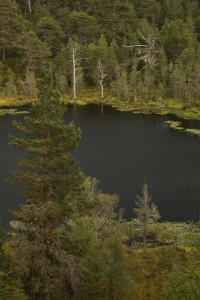
From there, I walked on quickly towards Coire Loch without stopping to take any more photographs. Reaching the overlook above the loch itself, I was fortunate to get a brief glimpse of the sun shining on the trees all around it, as clouds rapidly filled the sky.
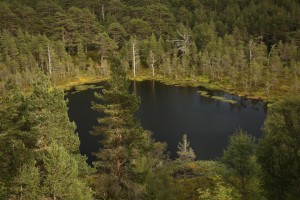
Soon enough it was time to head back to my car for the journey home, but I was very satisfied to have reached the loch as it was a sign of the increased mobility that was coming back to me, and to my leg in particular, as I recovered from the sciatica. I’d also had a great day along the way, finding enough of interest to fill two extensive blog entries like this!
Leave a Reply